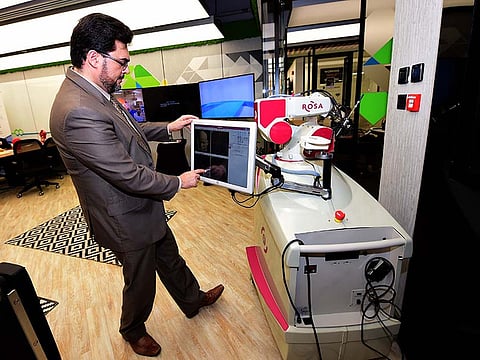Tomorrow’s health tech today
DHA is working with private companies from across the world to implement cutting-edge technologies to provide patients with the very best standards of care

The power to have our health in our hands is getting more real with every passing day thanks to emerging technologies. While tracking and monitoring our exercise and eating patterns already exists, now get ready to track all your important vitals.
As I sat at the Dubai Future Foundation’s Dubai Accelerator’s Office, I was presented with a tiny device that was connected through Bluetooth to my mobile phone. All I needed to do was keep my fingers on the device and in less than two minutes, I was able to get accurate details of six vitals: blood pressure, temperature, heart rate, ECG, blood sugar and oxygen levels.
ECG on a portal mobile pocket-sized app certainly felt like a much simpler and convenient method than last year, when I went to hospital and I was strapped to several wires. For someone who is not a technology junkie, I could not help but ask, “What is the accuracy of this device and is this ECG sufficient to detect abnormalities or does one need the conventional ECG scan?”
Rohini Kaul, Co-founder of Scanbo Technologies, said, “We have tested the results and have received a license after the accuracy was thoroughly checked. In fact, we have patented a device for 12 vital signs and are working on the one that can provide 18 vital signs. This ECG reader is a good enough indication for detecting any abnormalities. The idea is to empower the patient to self-check regularly and have a history of the previous reports on the app. This app can be accessed by doctors so it allows both the patient and the doctor to foresee any minute deviation for early intervention and further investigation.”
Scanbo Technologies is one of the companies working with the DHA’s Dubai Future Accelerators office. Over the next nine weeks, these companies will present proof of concepts and pilot projects at DHA hospitals to see how this technology can be incorporated in Dubai.
Dr Mohammed Redha, Director of Project Management Office, Informatics & Smart Health at Dubai Health Authority, said, “Continuing our ongoing commitment to incorporate innovation and technology in healthcare, DHA has selected several cutting-edge global firms for the fifth Cohort of the Dubai Future Accelerators Initiative. In the fourth cycle, we focused on Artificial Intelligence (AI) and its deployment in the healthcare setting. The direct positive impact of this initiative has been phenomenal. Now, in its fifth cycle, we are keen to further explore the use of these technologies.”
Dr Shatha Al Ali from DHA’s Future team told Better Health that the previous cycles have proved to be successful with technologies such as 3D printing becoming mainstream in DHA’s dental centres as well as being used for complicated surgeries andprosthetics for amputees.
Remote doctors for specialised surgeries
Another technology being assessed is a cloud-based augmented reality platform, which allows doctors to virtually transport themselves into any operating room or clinic to collaborate, guide and support surgeons.
The technology is being used in several countries including South Africa for complicated surgeons for children with cleft lips. Tariq El-Titi, Commercial Director of Proximie, said, “The technology virtually allows doctors to scrub in without being in the operation theatre. The technology literally augments the transmission of the real physical world on screen with additional, digitally generated content. It allows remote “hands-on” virtual assistance and provides specialised care and input at affordable costs.”
Robotic assistant for surgeries
Amer Khayel from Amico explains how his company supplies a robotic assistant known as ‘Rosa’ that employs a similar technology and it has a robotic arm. Khayal, said: “Instead of the surgeon having to navigate during surgery the robotic arm will do it on the surgeon’s behalf.
If the surgeon has a surgical plan they are just going to specify their entry points and targets once that is done the robotic arm will put that in that trajectory so the surgeon does not need to hold the instruments.”
Sign up for the Daily Briefing
Get the latest news and updates straight to your inbox



